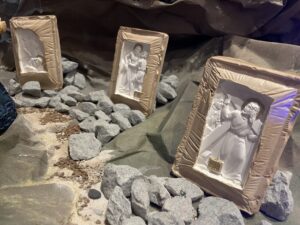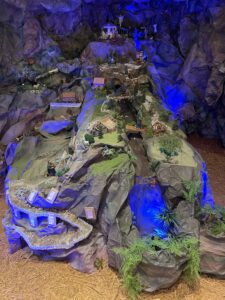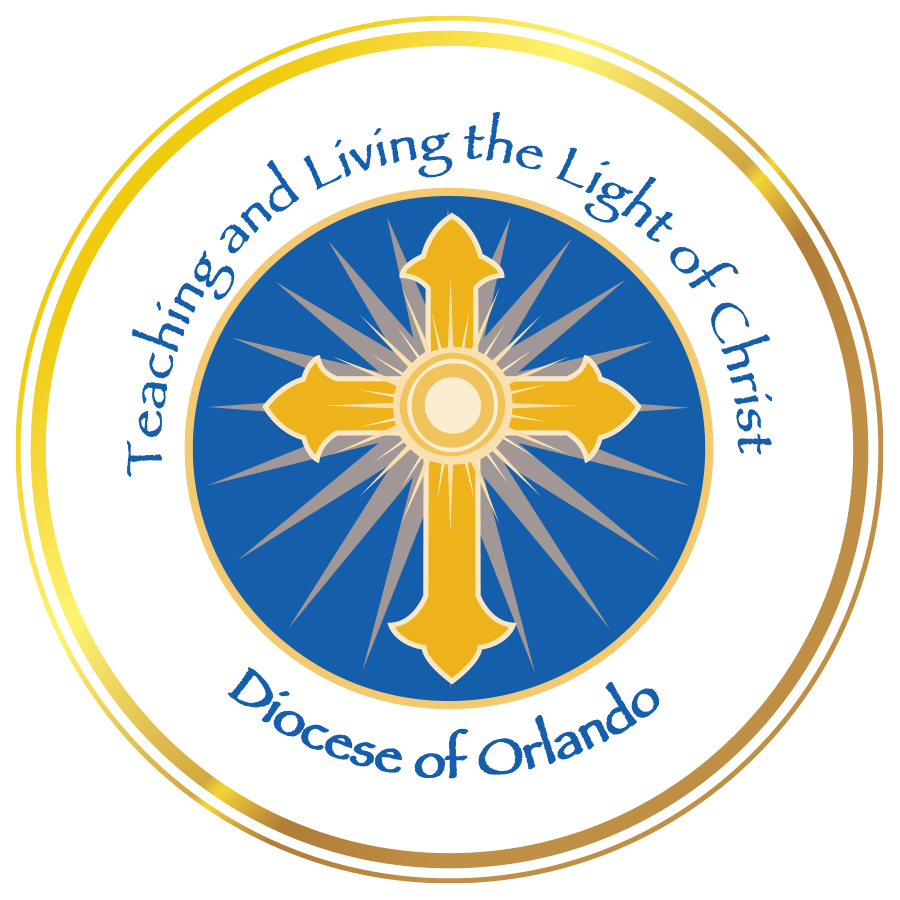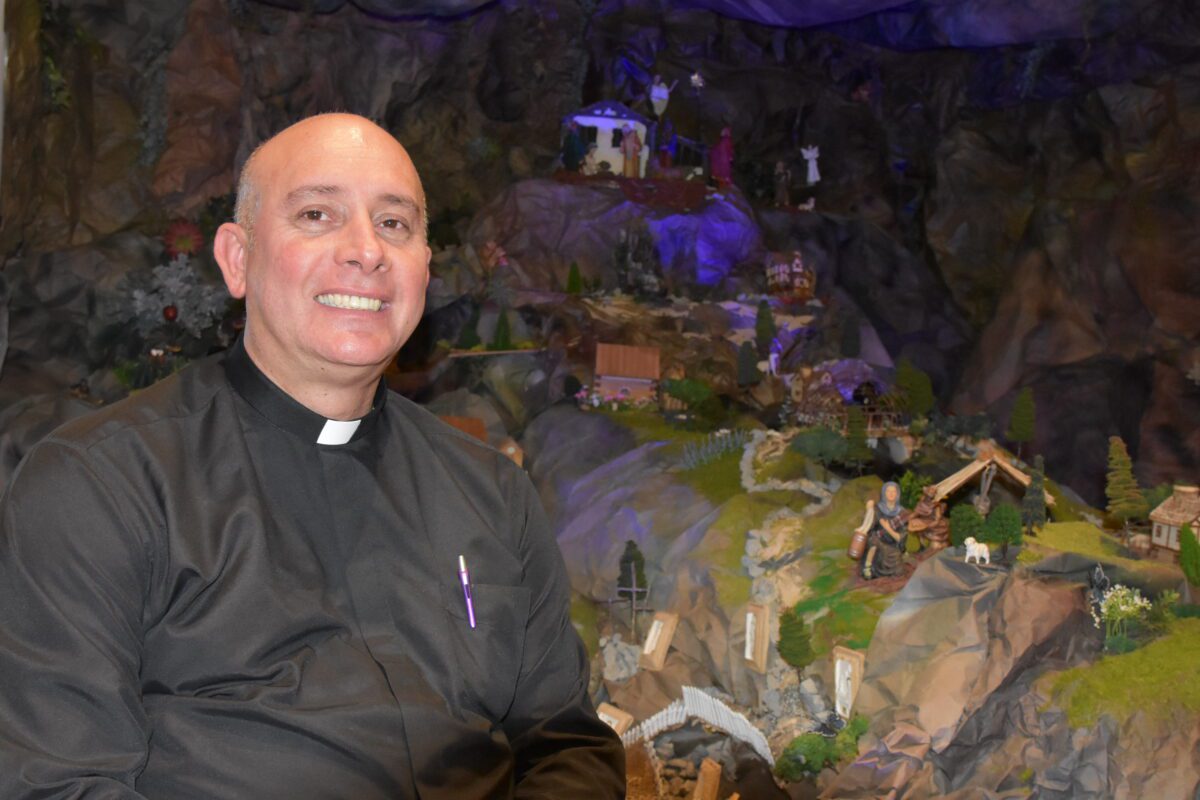ROCKLEDGE | Before becoming a priest, Father Juan Osorno considered becoming a painter. Gifted with a creative ability and artistic insight, one of his mentors wondered if he was on the right path. Certain of God’s desire for him, Father Osorno continued in formation and is now parochial administrator of St. Mary Parish in Rockledge. He uses his creative gifts to speak the Word of God into art and expand the faithful’s view of salvation history.
The idea took root more than one year ago when he decided to create a nativity scene for his home that depicted, not only the traditional scene of the Holy Family in a stable, but also “the Word made flesh” across all of salvation history. Pleased with the result, he planned an even larger display for his parish sanctuary. The outcome is a massive diorama that will remain on display through Feb. 2, the Presentation of the Lord.

With the help of parishioners Juliana Rubio, Julia Certuche and parish youth, Father Osorno brought his design to life. Scenes from Genesis, the flood, desert, the woman at the well, Via Dolorosa and Christ’s birth are manifested through hand-crafted pine trees, bits of small stones and wood, grass that looks real and other thoughtful details.
As Father Osorno fiddled with lights and repositioned the magi, he explained, “When I do something artistic, it is exactly the same as when I preach.” He explained that Christ taught him, “in a very powerful way, to understand that artistic talent is not just painting.” “Painting is one of the expressions of the talents that are there. Being an artist is a special intelligence that will help you see the world differently.”
His unique vision comes to life as he lays out God’s relationship with and love for humanity.
Bridges recall the passage cleared for the Israelites by God through the Red Sea, but also connect the Old and New Testaments. Illustrating a transcendence of time and space, water flows from a trunk symbolizing “the root of Jesse” at the upper center of the scene and throughout the vignettes of this salvation story. From there the water runs “to the Garden of Eden, the place where everything was created green and beautiful and the main river.”
Father Osorno explains why water is his central image. “It reminds us about the place where the water runs in the streams, like (Psalm 1:3) says, where every tree and everything flourishes and lives.”
Because water is critical to the display, he wanted to have real water flowing through it. He set up a pump and painted foil “tunnels”, enabling flow without damaging its channels or surroundings.
“We recognize God through beauty, goodness, and truth,” Father Osorno said. “God is true, beautiful, and good. All creation reflects Christ Jesus, the Word who became flesh through whom everything was created. Everything reflects God. When you are an artist you can see beauty everywhere.”

From the woman at the well speaking to Jesus, learning He is “living water”, the stream also represents the sacramental grace of Baptism – “being reborn with Christ through a new life,” he said. “As Jesus is giving us His living water, like when He was crucified and crossed with the lance, pouring water and blood from His side (the Sacraments of Baptism and Eucharist), the water points to the sacramental life that He is giving us. The nativity scene represents what the water represents… passion, death and life through the resurrection.”
As Father Osorno explores the layered depths of this creative feat, he draws attention to the hay in which Jesus lays in the manger – “the place of the hay becoming food for our lives.” He notes its symbolism – “the Eucharist and the death He will suffer for us for our salvation.”
A close look at the imposing diorama is like taking a walk through the books of the bible culminating in God’s plan of redemption. Citing Jn 1:14, “The Word was made flesh and dwelt among us,” he unpacks what this means for humanity in terms of daily and eternal life. “That word was the Word from whom everything was created—God himself. Nothing exists without Him. So, the nativity scene reminds us of Jesus who was incarnate in His own existence, in His own life as flesh, and became that precisely which gives life.”
Bishop John Noonan agrees. “The diorama is beautiful and majestic as it manifests the story of salvation and helps us understand the anamnesis of the Eucharist,” he shared.
What Father Osorno loves about being an artist “is to see the grace of God flowing through me, through the gift He has given me.” Artistry is expressed in a multitude of ways. He noted, “When I preach, the artist in me comes out. I see beauty in His word, in His work, in His action, in His redemptive work and how He manifests himself in our lives and that of all humanity throughout history. Re-creating that is an experience that gives you joy.”
By Glenda Meekins of the Florida Catholic Staff, January 26, 2022

